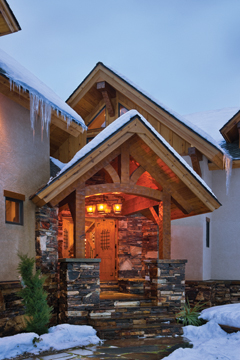The maintenance of a log, timber frame, or hybrid home is a saga of planning and vigilance that begins even before the structure is completed.
These homes are regularly conceived, planned, and constructed with maintenance in mind. Further, maintenance involves the exterior and interior of the main structure and any outbuildings, as well as the planned landscaping and any vegetation that is indigenous to the lot or acreage where the home is located. Anticipating the maintenance that will be required presents a clear picture for the homeowner of the responsibilities that come along with truly enjoying their log, timber frame, or hybrid home and protecting their investment.
A basic checklist is a valuable tool that guides the homeowner in maintaining such a significant investment for years to come—and it begins at the beginning. Choose quality materials, and in the case of wood, logs, or beams, choose those that are prepared for construction by reputable companies. In evaluating the building site, consider the proximity of the structure to trees and brush, whose leaves, limbs, and trunks could be hazards during storms while debris could clog gutters and downspouts or harbor insects or other pests.
During the construction process evaluate the proper location and amount of landscaping needed. Refrain from planting shrubs too close to the home to prevent avenues of approach for insects, the trapping of moisture that could cause exterior wood to deteriorate, or the inefficient operation of external air and heating equipment.
Basic exterior maintenance for log, timber frame, and hybrid homes is similar to that of conventional homes with a few notable exceptions. Generally speaking, an annual inspection of the property should be done. Some homeowners actually keep a journal of maintenance completed and anticipated and set a budget of one to two percent of the home’s value for annual maintenance.

PrecisionCraft Log & Timber Homes /photo by Roger Wade Studio
Put your work clothes and boots on and walk the property. Inspect such potential problem points as roof shingles, chimneys, vents, skylights, gutters, and drains. Replace the batteries in smoke detectors. Evaluate exterior stain and sealant on wood surfaces to determine whether touch-up or restaining is needed due to mildew, thinning, or cracking of the surface. Moisture may well collect in cracks or crevices and lead to wood decay. Look for areas where window seals or caulking may have fallen away or deteriorated. A new bead of caulk may prevent a nasty leak from a roof or window.
Another annual checklist item that is surprisingly often overlooked is the general cleanliness of the log, timber frame, or hybrid home’s exterior. Pressure washing the home sharpens its looks and removes damaging pollen and dust. Birds nesting around a home’s exterior—for example, swallows that pack mud into their nests—may cause problems. Be wary of these visitors. Keep piles of firewood away from the home to avoid unwanted encounters with snakes, rodents, insects, and again the ever present possibility of gathering moisture.
When homeowners consider a maintenance regimen, their attention regularly turns to the local climate, the change of seasons, and the impact of sun, rain, snow, ice, heat, and cold on their log, timber frame, or hybrid home. Those homes in locations that receive heavy snow in winter are often subject to moisture problems, and the roofing design must be engineered safely. The weight of a heavy snow may collapse a roof, and snow has been known to slide off a roof with an extreme pitch, causing an adjacent deck to collapse, or even serious injury to individuals below.
Prolonged periods of cold may cause both exterior and interior pipes to freeze. Interior pipes should be insulated, and exterior pipes should be drained in late autumn with their water source shut off. Conversely, extended periods of sunlight and heat will dry exterior surfaces and possibly cause unwanted cracks or exterior fire hazards. Sealants and protectants should be appropriate for weather and climate conditions, and dry brush or dead shrubbery should be removed. Make sure chimneys are clean and cleared before lighting the first fire of the season.
The interior of a log, timber frame, or hybrid home requires maintenance as well. Major appliances, interior drains, plumbing fixtures, water heaters, and gas lines should be inspected at least annually, while filters on heating and air units should be changed with the seasons. Exposed interior wood needs periodic cleaning and stain or sealant upkeep. Window and door frames should be checked, and if the owner sees daylight in the seal area, work needs to be done. Windows and skylights filter the amount of sunlight that enters a room, and choosing these carefully during construction helps minimize maintenance and repair due to fading or cracking from exposure to direct sunlight.
A solid maintenance routine saves time and money while extending the life of that dream home, whether log, timber frame, or hybrid. Proper maintenance retains and enhances the home’s value as well. Perhaps most important, maintenance offers peace of mind and minimizes the risk of an unpleasant and unplanned surprise.
by Mike Haskew

